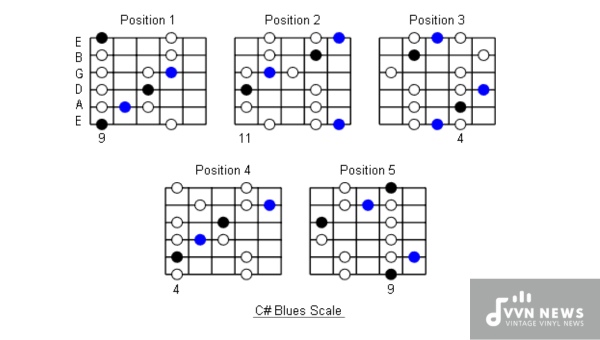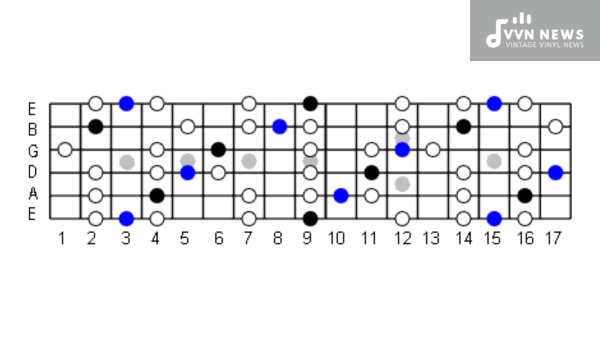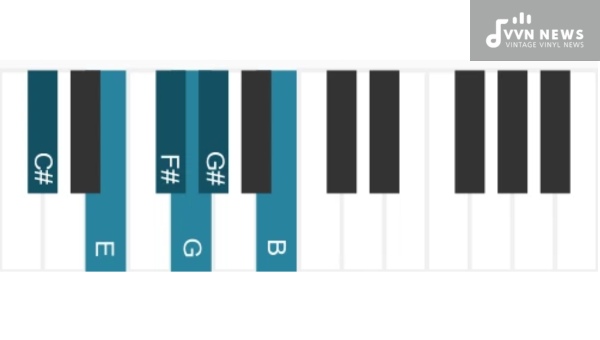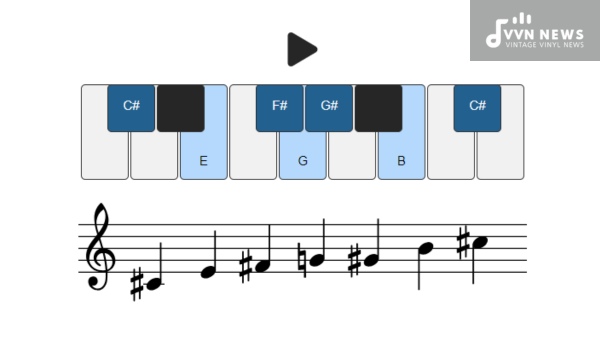Unlocking the soulful sound of blues music hinges on mastering its fundamental scales, and among these, the C sharp minor blues scale stands as a pivotal element for musicians aiming to infuse their playing with emotional depth and dynamic expression.
This particular scale grants guitarists and pianists alike the tools needed to weave those quintessentially bluesy tones through their melodies, providing a backbone for improvisation and composition within the genre.
The nuances of the C sharp minor blues scale is not just about learning a sequence of notes; it’s about discovering a new language of musical storytelling.
Whether you’re an aspiring musician refining your technique or an experienced player looking to add more shades to your sonic palette, knowledge of this scale will significantly enhance your musical repertoire.
So let’s walk through the essence of this timeless scale, ensuring that by the end of our journey, you’ll feel more connected to the rich heritage that is blues music.
What Notes Form the C Sharp Minor Blues Scale?
A fundamental aspect of blues music is its unique tonality, with the C sharp minor blues scale serving as a cornerstone for crafting that distinct sound.
This scale is a hexatonic (six-note) scale and a variant of the C sharp minor pentatonic.
The notes that compose this scale are C#, E, F#, G, G#, and B. Pronounced “C sharp,” “E natural,” “F sharp,” “G natural” (the blue note), “G sharp,” and “B natural,” these notes blend to produce rich, emotive melodies characteristic of blues tunes.
It’s the addition of G, the sharp fourth or flat fifth, which introduces the iconic dissonance responsible for those soul-stirring sounds.
How to Create the C Sharp Minor Blues Scale

Creating the C Sharp Minor Blues Scale is akin to unlocking a door to soulful expression.
Think of it as painting with a specific palette of notes that conjure the blues’ emotive atmosphere.
Follow these steps, and before you know it, you’ll be weaving musical tales with a bluesy twist.
Step 1: Start with the Natural Minor
Begin your progression on C#, followed by E, which is the minor third. You’ll then add F# (the fourth), G# (the fifth), and B (the seventh).
Step 2: Infuse the Blues Note
This scale obtains its characteristic sound from the blues note. Insert the B flat, or A#, between F# and G#—now you’ve crafted that distinctive bluesy essence.
Step 3: Complete The Scale
Round out your scale with an octave above your starting C#, signifying completion of one full cycle through these poignant tones.
Your finalized C Sharp Minor Blues Scale should consist of:
- C#
- E
- F#
- A# (Blues Note)
- G#
- B
- C# (Octave)
With these steps, you’ll have assembled a powerful musical tool—one that’s versatile for improvisation and rich in emotion.
Embrace this scale in your practice sessions, and watch as your melodies take on new depths.
Also Read: D Minor Pentatonic Scale [Make Your Music Sing With Emotion]
C Sharp Minor Blues Scale Positions
As you delve into the C Sharp Minor Blues Scale, it is crucial to become familiar with its various positions across the fretboard.
Learning these shapes expands your playing capabilities and offers unparalleled flexibility when improvising or composing.
Below, we’ll explore five distinct shapes that give you full access to the evocative power of this scale.
Shape 1: Root Position
Begin with the root shape, which starts on the 9th fret of the E string (your lowest string). Here, you encounter:
- C# – 9th fret, E string
- E – 12th fret, E string
- F# – 9th fret, A string
This shape is your “home base” and is often the first one players memorize.
Shape 2: The Fourth Fret Stretch
Moving up to the A string:
- G – 11th fret
- A – 12th fret
Keep a comfortable stretch in your fingers to navigate this area easily; dexterity here is pivotal.
Shape 3: Central Octave Leap
At this point, shift focus to octave articulation on the D and G strings:
- B at the 9th fret of D
- C# at the 11th fret
This reinforces melodic connections between octaves.
Shape 4: Upper Registers Blend
The B and high E strings introduce higher-pitched notes that sing with clarity:
- E on B’s 9th fret
- An expressive G on B’s 12th
Here, be mindful of intonation for those heartfelt expressions typical in blues.
Also Read: D Sharp Minor Pentatonic Scale [Inject Drama Into Your Melodies]
Shape 5: Pentatonic Connection
Transition smoothly into blues phrasing by integrating traditional minor pentatonic shapes parallel to your C sharp minor scale framework:
- Tap into familiar pentatonic patterns
- Layer your blues notes for depth
By mastering these positions across your instrument’s neck, you set a firm foundation for genuinely captivating blues performance.
Please familiarize yourself with each shape from memory and practice transitioning between them fluidly.
How do C Sharp Major and Minor Blues Scales Differ?

When delving into the world of blues scales, it’s crucial to grasp the distinct characteristics that set the C sharp major and minor blues scales apart.
While they share a similar name and some common notes, they create entirely different moods and textures within music.
The C Sharp Minor Blues Scale
The C sharp minor blues scale thrives on a palette of somber, moody vibes, thanks to its minor third interval. It’s comprised of six notes:
- C#
- E
- F#
- G
- G#
- B
The inclusion of the flat fifth (G), or “blue note,” introduces that signature bluesy dissonance which delivers a layer of emotional complexity and tension to the scale.
The C Sharp Major Blues Scale
Conversely, the C sharp major blues scale celebrates a brighter sound profile.
Though also constituted by six notes, its foundation is the major third interval which offers an unmistakably more upbeat atmosphere:
- C#
- E#
- F#
- Fx (or G)
- G#
- A#
In this scale, the sharp fourth (Fx) or flat fifth serves as the blue note. Its primary role is to bridge the gap between two harmony-friendly intervals, which are essential for producing a warmer and cheerier tonal quality.
By embracing each scale’s unique elements when jamming or composing in C#, you can knowingly dictate your music’s emotional direction while adding depth to your creative arsenal.
Also Read: G Flat Minor Pentatonic Scale [Interesting Tones For Your Music]
Why Learn Ear Training for C Sharp Minor Blues Scale?
Mastering the C sharp minor blues scale through ear training is a game-changer for any musician.
It’s about much more than just recognizing intervals and chords; it’s a journey towards intuitive musical expression.
Enhances Improvisational Skills
Ear training sharpens your ability to anticipate chord changes and weave improvisations that are both complex and coherent. Musicians adept at this can craft solos that feel as natural as conversation.
Strengthens Musical Intuition
Learning the scale by ear cultivates an instinctive grasp of melodic direction and emotional impact. Hear a note, and instantly know where it sits in the scale; this skill is invaluable.
Speeds Up Fretboard Navigation
Guitarists benefit by associating sounds with specific fretboard positions. This mental mapping makes it easier to glide through runs and riffs without hesitation.
Boosts Transcription Abilities
Transcribing music becomes less daunting when you can easily identify the notes of the C sharp minor blues scale by ear. It allows you to write down music accurately while listening, which is a critical skill for any musician.
Promotes Expressiveness
The blues are all about feeling. Ear training ensures you’re not just playing notes; you’re conveying emotions. It adds a layer of soul to every note struck, making performances more poignant.
Aids in Harmonization
Vocalists and instrumentalists alike can benefit from ear training when harmonizing with bandmates or other instruments, as it helps in creating complementary lines that enhance the overall sound.
By dedicating time to ear training within the framework of the C sharp minor blues scale, you’re not just memorizing; you’re empowering yourself with intuitive musicianship that will set your playing apart.
Also Read: G Minor Pentatonic Scale [Create Engaging Solos & Improvisations]
Ideal Practice Tracks for C Sharp Minor Blues Scale

The journey to fluency in the C sharp minor blues scale can be both thrilling and challenging.
To aid your progression, incorporating a variety of practice tracks is essential.
These tracks not only provide a solid rhythmic foundation but also inspire creativity and help ingrain the scale into your musical intuition.
Here are some excellent backing tracks to get you started:
1. “Slow Blues in C# Minor”
This track offers a laid-back tempo that allows plenty of space for you to explore the nuances of the scale. It keeps a steady beat, serving as an inviting canvas for your improvisational brushstrokes.
2. “C# Minor Funky Groove”
Infuse your blues practice with some funk. The syncopated rhythms juxtapose nicely against the wailing notes of the minor blues scale, challenging you to keep your playing tight and in-sync with groove-heavy bass lines.
3. “Jazzy Blues Backing Track in C Sharp Minor”
With complex chord changes and sophisticated harmonies, this jazzy backing track tests your ability to adapt the C sharp minor blues scale over different contexts, thus sharpening melodic intuition.
4. “C# Minor Rock Ballad”
Rock ballads often feature hearty emotional expressions, making them perfect for practicing longer, more soulful phrasing with the blues scale.
5. “Uptempo Shuffle in C# Minor”
A higher tempo means less time to think and more reliance on instinctual playing — a great way to solidify your grasp on the scale’s patterns across the fretboard or keyboard.
When searching for tracks, remember key compatibility; you might find practice tracks listed under Db (D flat) minor – this is enharmonically equivalent to C sharp minor and, therefore, perfectly suitable.
Utilizing these backing tracks will undoubtedly accelerate your skills in applying the C sharp minor blues scale into real-time playing situations.
FAQs about the C Sharp Minor Blues Scale
What is the C Sharp Minor Blues Scale?
The C sharp minor blues scale is a six-note scale that’s central to creating the emotional and soulful sounds typical in blues music.
Is the C Sharp Minor Blues Scale only used in blues genres?
No, while it’s foundational in blues, this flexible scale is also frequently utilized in jazz, rock, and even pop music for its expressive qualities.
How often should I practice the C Sharp Minor Blues Scale?
Consistent daily practice, even if it’s just a few minutes each day, can greatly improve your familiarity and agility with the scale.
Can I use the C Sharp Minor Blues Scale over chord progressions?
Absolutely! This scale can be played over various chord progressions, particularly those in a minor key, to create a cohesive bluesy feel.
Do I need to learn other keys after mastering C sharp minor?
Yes, learning blues scales in all keys broadens your musical skills and allows you to play with other musicians or transpose songs easily.
Conclusion
Embracing the C sharp minor blues scale is a transformative experience, enriching your musical versatility and deepening your emotional expression.
With its blend of somber tones and heartfelt empathy, it opens doors to a realm where every note resonates with poignant narratives.
Practice diligently, immerse yourself in listening to blues classics, and integrate this scale not just in your fingers, but in your soul.
Remember, the beauty of the blues lies within its raw honesty—so play boldly, from the heart.








